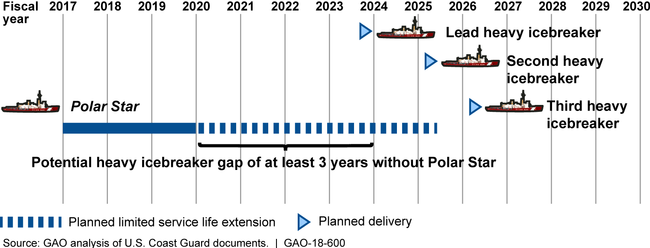Dark Skies for America’s Future Icebreaker Fleet

USCGC Polar Star icebreaker sits hove-to outside McMurdo Station, Antarctica. (Photo: PA2 Mariana O'Leary)
A new report published by the U.S. Government Accountability Office (GAO) casts a dark cloud over the icy shimmer of hope that the Coast Guard will be able to deliver on its 2023 icebreaker promise.
Earlier this year, the U.S. Coast Guard and Navy announced plans to invest up to $9.8 billion USD to build and maintain three heavy polar icebreakers to conduct missions in the Arctic and Antarctic. If the current schedule is kept, the first of these ships is scheduled for delivery in 2023.
The announcement was big – and long awaited – news for American military and government leaders alike. The United States last commissioned an icebreaker in 1978, the Polar Sea, which has been out of service since 2010. Its sister ship, the Polar Star commissioned in 1976, is currently the United States’ only operating heavy icebreaker.
While the U.S. Coast Guard has two smaller polar class icebreakers currently in use, these three U.S. ships stand in stark contrast to Russia’s 41 and Canada’s 6.
In their new report released this month, the Government Accountability Office has found that the U.S. Coast Guard does not have a sound business case for the cost, schedule, and performance baselines for its heavy polar icebreaker acquisition program.
The GAO is America’s internal legislative watchdog, charged by Congress to investigate how the federal government spends taxpayer dollars through rigorous auditing, investigating, and reporting.
Both old-fashioned and economically extravagant.
Their northern portfolio has offered a sharp analysis on everything from relocation costs of climate change-impacted Alaskan villages to assessing the economic viability of drilling in the Arctic National Wildlife Refuge.
Bad News for Proposed U.S. Icebreakers
Their newest Arctic report takes aim at the U.S. Coast Guard and its highly-anticipated future icebreakers. Their investigation has found that the icebreaker acquisition program is at risk of having an unstable design because the Coast Guard set program baselines before conducting a preliminary design review.
The Coast Guard also failed to conduct a technology readiness assessment, underrepresenting the program’s technical risk.
More critical still are the GAO’s findings on cost and schedule. The $9.8 billion icebreaker price tag is only partially credible or reliable, and may underestimate the total funding needed for the program. And the scheduled delivery dates are based on the Polar Star reaches the end of its service life, rather than planning on a realistic assessment of shipbuilding activities.
These shortcomings have led the GAO to make six recommendations to the Coast Guard, Department of Homeland Security, and the Navy to "conduct a technology readiness assessment, re-evaluate its cost estimate and develop a schedule according to best practices, and update program baselines following a preliminary design review."
The Department of Homeland Security agreed with all six recommendations.

The GAO's analysis of selected lead ships for other shipbuilding programs found the icebreaker program's estimated construction time of 3 years is optimistic. As a result, the Coast Guard is at risk of not delivering the icebreakers when promised and the potential gap in icebreaking capabilities could widen. (Illustration: GAO)
Shared Icebreakers as a New Way Forward
These findings are a hard hit for a country that has waited forty years for a new icebreaker; but all hope may not be lost.
Eero Hokkanen, Communications Manager of Arctia Finland, tells High North News that our frame of reference for icebreakers is all wrong.
"Thinking of icebreakers as strictly national assets with national funding and tasks is both old-fashioned and economically extravagant," Mr. Hokkanen says.
"The vast majority of tasks done by icebreakers in the Arctic are non-military in nature: fairway icebreaking, ice management, towing, harbor icebreaking, Arctic sealift to remote communities, research, oil spill preparedness and response. These are not reliant on an icebreaker with a specific flag, they rely on icebreaking services."
Arctia, a limited company owned by the state of Finland, imagines a world where countries like the U.S. no longer need to construct their own icebreakers – they could share them instead. Comparing their services to an ‘Uber of icebreakers’ Earo envisions Arctia leading the way in icebreaker loaning.
"Unfortunately nations and stakeholders in need of icebreaking services do not share information on their needs and know-how on maritime assets as much as they perhaps should," Mr. Hokkanen laments.
Protectionism slows down competition and makes companies fat and lazy.
"If multiple research institutions pooled their resources together, they would certainly be able to charter more capable icebreakers than before. The Arctic Research Icebreaker Consortium (ARICE) is a shining example of sharing for common good, but it still fails to take in to account commercial vessels, that have higher ice-class than most research vessels in use today and that can very easily be modified for polar research."
One of the biggest challenges Arctia faces is the financial framework of the north, which is predicated on real and rhetorical nationalism.
"Financial nationalism inhibits the use of best available services and technologies," Mr. Hokkanen explains.
"Protectionism slows down competition and makes companies fat and lazy. Instead of reducing emissions by new innovative blue solutions, corporations can cope with aged technologies. This, however, is short-sighted."
Mr. Hokkanen and the Arctia team are cautiously optimistic about their icebreaker pursuits.
"By sharing the cost of designing, building and operating icebreakers, Arctic nations can save money, increase the usage rate of icebreakers, but also build stability in the region."
It is unlikely that the U.S. Coast Guard changes course to icebreaker sharing rather than constructing its own. Still, it will be another five years at the earliest that the U.S. delivers its next icebreaker. If that schedule falls behind or Polar Star exhibits a shorter-than-expected lifespan, icebreaker sharing may well be America’s only option.

Eero Hokkanen, Communications Manager of Arctia Finland (Photo: Arctia)
